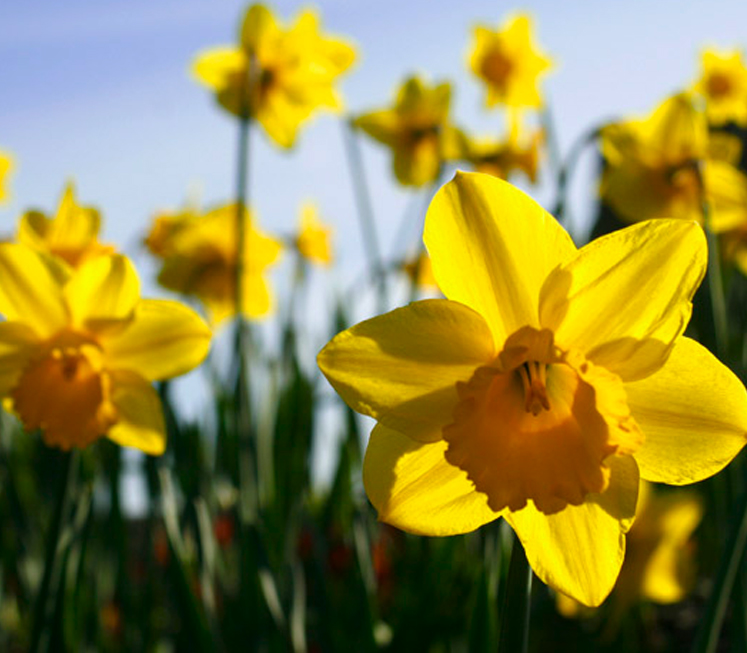March in the Garden, Top Tips

By March, we’re ready to welcome the start of spring – a hopeful, happy time for gardeners.
Timely Tips
This month’s timely tips are all about getting a head start in the garden.
- Fertilise your beds. Once your soil is workable, dig a 5cm (or more) layer of compost or well-rotted manure into your beds to prepare for the growing season ahead. You can also work in a general-purpose fertiliser, such as pelleted chicken manure, or fish, blood and bone.
- Put supports in. If any of your garden plants need supporting this year, put them in now, so plants can grow up through them. Adding supports afterwards is trickier and often looks unattractive.
- Move deciduous trees or shrubs. Now is the time to do this task, provided the soil isn’t frozen or waterlogged.
- Resurface paths before plants start to grow and smother them.
In the flower garden
Here are your main tasks in the flower garden this month:
- Feed trees, shrubs and hedges with a slow-release fertiliser by lightly forking it into the soil surface.
- Feed roses with special rose feed or balanced fertiliser as they come into growth.
- Prune roses to encourage strong new growth.
- Prune clematis – prune early-flowering varieties once their flowers have finished and summer-flowering ones before they start into active growth. Check our clematis pruning guide for more detailed instructions.
- Finish cutting back cornus and salix cultivars, and other shrubs grown for their colourful winter stems. Cut them right back to their bases.
- Cut out the top rosette of leaves from mahonia shrubs after they have flowered, to encourage branching.
- Finish cutting back dead foliage from perennials and ornamental grasses to make way for new growth.
- Prune overwintered fuchsias back to one or two buds on each shoot.
- Prune winter-flowering jasmine (Jasminum nudiflorum) after flowering, to encourage new growth for next year’s blooms. Cut back the previous year’s growth to 5cm from the old wood.
- Trim winter-flowering heathers as the flowers disappear, to prevent the plants becoming leggy.
- Keep an eye out for slugs as the weather warms. Pay special attention to soft, new growth, which slugs love. Use nematodes for an effective organic control.
- Cut the old leaves off hellebores to remove any foliar diseases and make spring flowers more visible.
- Continue to deadhead winter pansies to stop them setting seed. This will encourage flushes of new flowers throughout the spring.
- Deadhead daffodils as the flowers finish and let the foliage die back naturally.
- Deadhead hydrangeas before new growth appears. Cut to about one third of last season’s growth.
- Plant native hedges to encourage wildlife.
In the vegetable garden
Here are your vegetable garden jobs for this month:
- Dig in green manures grown over the winter. Do this while stems are still soft.
- Dig compost, well-rotted manure or green waste into your vegetable beds to prepare for the growing season ahead. Dig in a 5cm (or more) layer when the soil becomes workable.
- Weed vegetable seed beds.
- Cover prepared soil with sheets of black plastic to keep it drier and warmer in preparation for planting.
- Weed and mulch asparagus beds. Asparagus has shallow roots so weed by hand to prevent damage.
In the fruit garden
Trim, feed and protect plants in the fruit garden:
- Cut autumn-fruiting raspberry canes to the ground to stimulate new canes, which will fruit in the autumn.
- Cut the tips of summer-fruiting raspberry canes that have grown beyond the top of their supports; cut just above a bud.
- Feed blueberry plants with ericaceous plant fertiliser.
- Protect the blossoms of apricots, peaches and nectarines from frost with a screen or horticultural fleece.
- Mulch fruit trees with well-rotted manure or garden compost. Take care not to mound mulch up around tree trunks.
- Cover strawberries with a cloche to encourage earlier fruiting.
- Mulch rhubarb with a thick layer of well-rotted manure to keep it healthy and reduce moisture loss through the soil. Take care not to cover the crown.
Looking after your lawn
Here’s how to look after your lawn this March:
- Recut any lawn edges if necessary.
- Install lawn edging to make future maintenance easier.
- Mow your lawn if it needs it. Choose a dry day and set your blades higher than usual.
- Lay new turf if the ground isn’t frozen or waterlogged.
- Prepare soil for growing new lawn from seed. Doing this now allows it time to settle before sowing.
Other jobs about the garden
Here are the other jobs to be getting on with this month:
- Install a new pond or water feature.
- Remove any pond netting left over from the autumn/winter.
- Get rid of slimy patches on patios and paving by scrubbing with a broom or blasting with a pressure washer.
- Install water butts for the season ahead. Position them under a downpipe to make the most of rainfall.
- Scrub watering cans to prevent fungal diseases.
- Build a compost bin before the growing season gets underway.
- Create a comfrey bedto make your own organic fertiliser. Sow into a seedbed in an unused corner of the garden.
- Check compost bins to see if there is any compost ready to use.
- Bring bags of compost into the greenhouse to warm up for a week or two before you start sowing.
- Invest in a soil-testing kit if you don’t already know what type of soil you have. It will help you choose the right plants for your garden.
- Top up raised beds with compost and good quality topsoil.
- Begin weeding as the weather warms – it’s easier to control weeds if you remove them while they’re still young.
- Check containers to ensure the soil hasn’t dried out.
- Top-dress containers by removing the top 2.5cm (1″) of soil, and replacing it with fresh compost.
- Ventilate greenhouses and cold frames on warm days.
- Move plants from the greenhouse to a cold frame before planting out to give them time to adjust to cooler temperatures.
From your armchair
- Order seeds and plug plants now, ready for beautiful containers and hanging baskets this year.
- Order fruit trees for planting this spring. If space is limited in your garden try growing dwarf fruit trees.
- Buy vegetable plants for a hassle-free start to your vegetable garden.
- Sort your seeds by sowing date, month by month.
- Start a sowing and growing diary to keep track of which seeds you are sowing and when they were sown – it really helps later in the year.
- Consider using green waste to improve your soil; visit your local council’s website for information.
You might also like
Popular posts
Subscribe
For relevant updates on Emergency Services news and events, subscribe to EmergencyServices.ie









